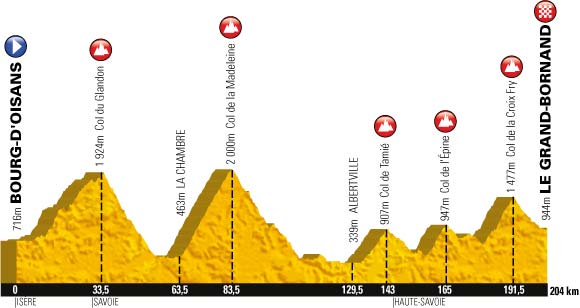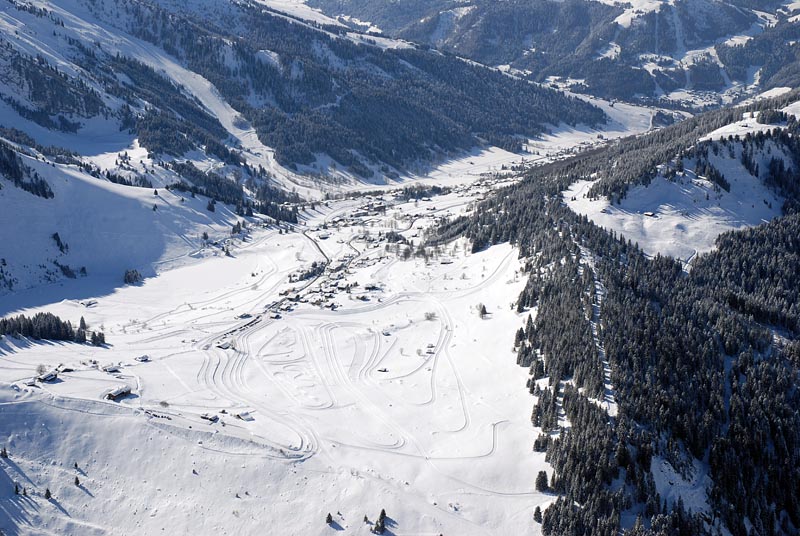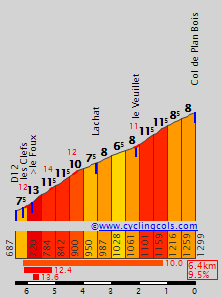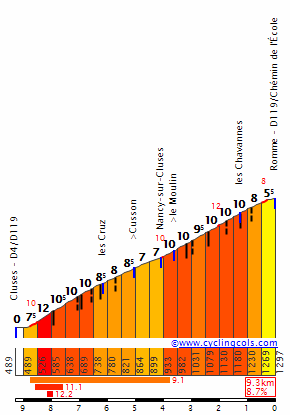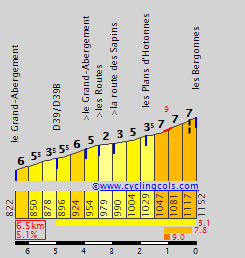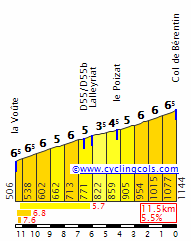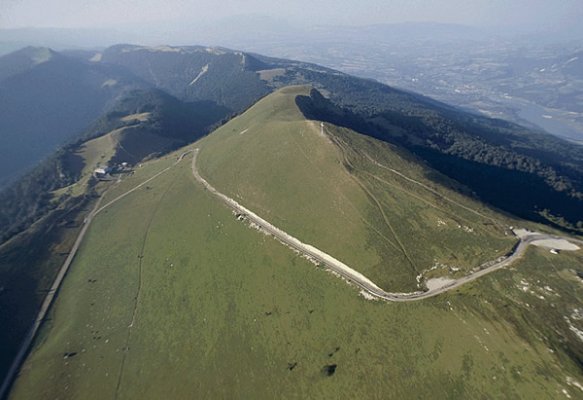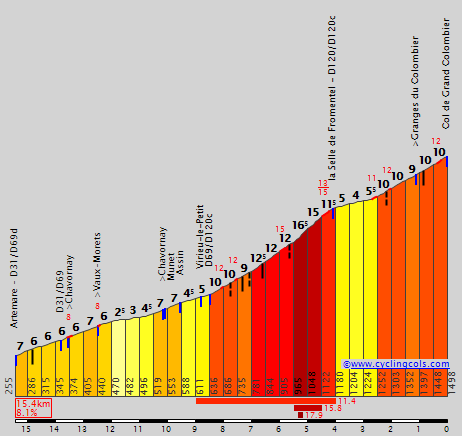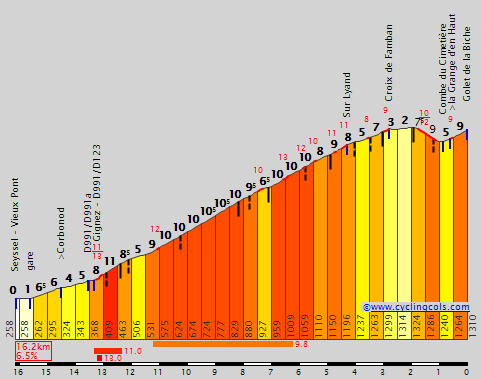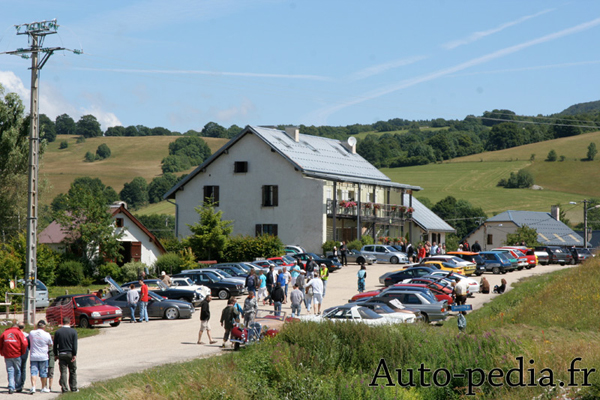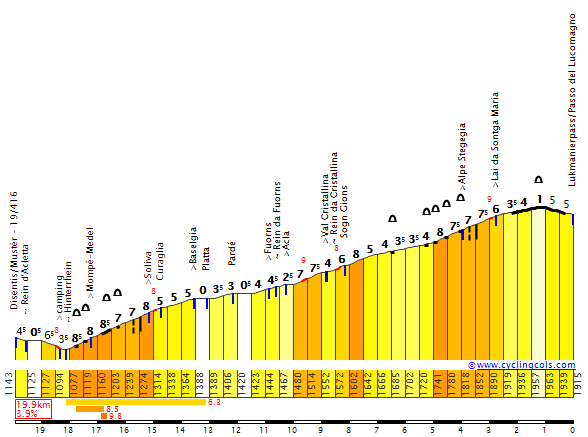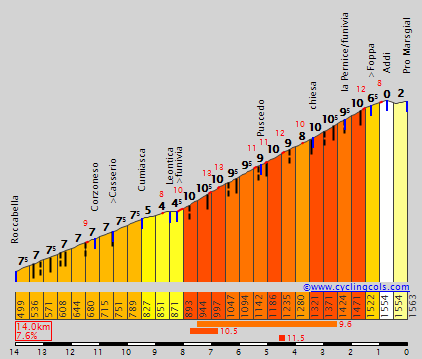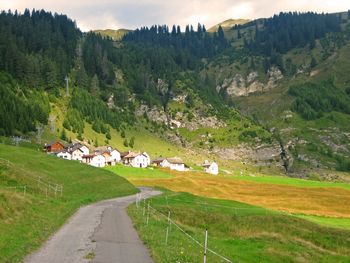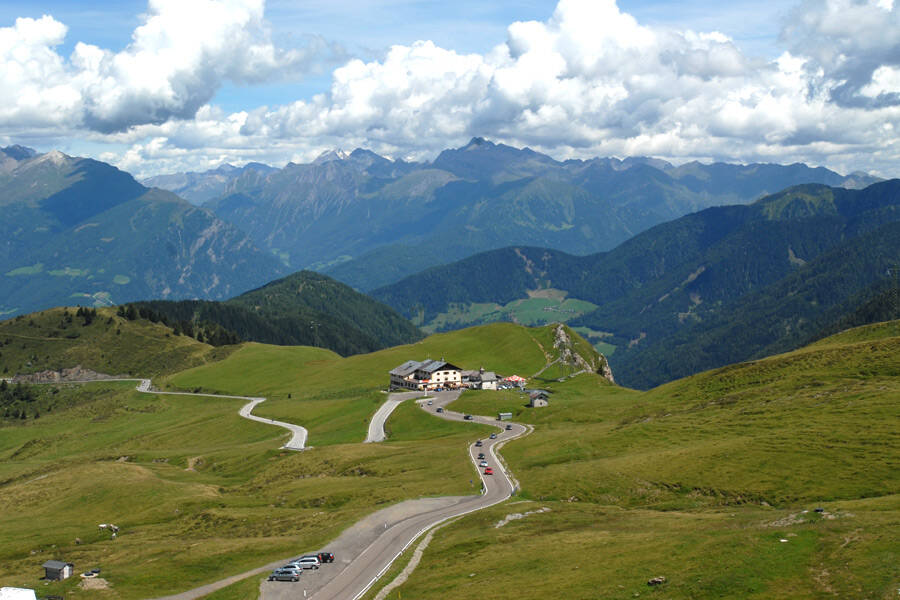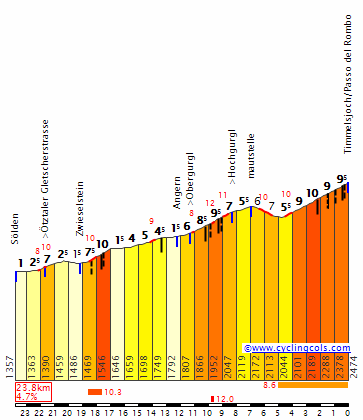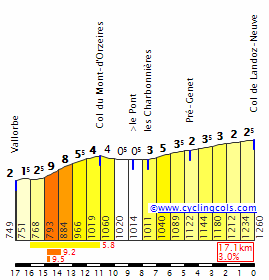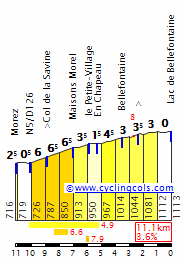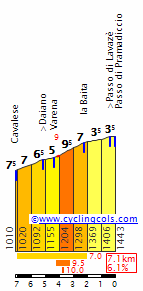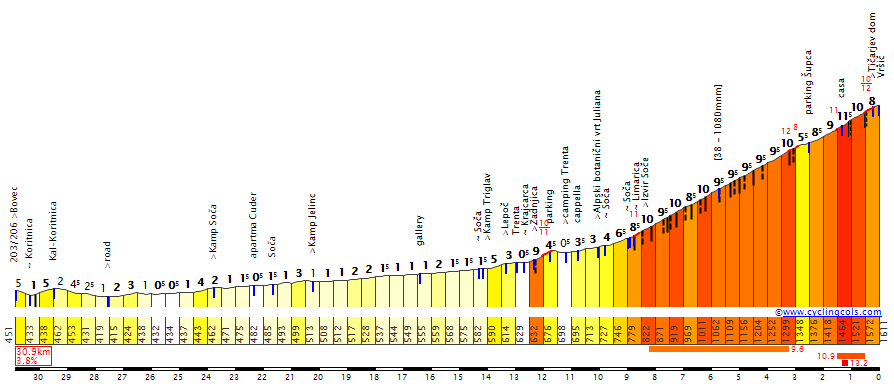Nordic Series 4: Ridnaun-Val Ridanna
In a northern corner of Südtirol, close to the Brennerpass, there's a trunk road in to a small and relatively quiet valley, at the top of which is a biathlon venue which encroaches into the neighbouring village. Ridnaun-Val Ridanna has become a regular host of the IBU Cup since the rebuilding of the biathlon stadium, most notably hosting the European Championships in 2011 (and scheduled to host them agains in 2018), and also the
national championships in 2012. With Antholz-Anterselva having such a vice-like grip on the Italian World Cup round (it's part of the traditional 'biathlon trophy' triple-header of Oberhof, Ruhpolding and Antholz that comes in the New Year period) and a glut of cross-country World Cup venues, it has reinvented itself as a training centre par excellence, and with relatively high altitude and
good snow-making facilities in the event of substandard weather, it provides ample opportunity for training camps, with the German and Italian teams being particularly fond of the site (of note, the Ratschings area is one where despite the mining tradition, the aggressive Italianization policies Mussolini adopted towards the Südtirol had little effect in this relatively isolated location, and the German language is still absolutely dominant to this day). It's also one of the most scenic venues on the world calendar, with the narrow valley spread out on both sides and with the trails
nudging right up against the houses and hotels of the neighbouring village - however the fact that so much of the venue is open to the elements rather than seeing the athletes swooping through the trees like in most of the Scandinavian, German and Russian venues, it introduces a couple of additional factors - firstly that the athletes can see their opponents much better than on a course through forestry where the same 'out of sight out of mind' principle that we see with regards to breakaways in cycling can be applied; and secondly, there's very little to prevent the wind from battering the athletes in the range. Fortunately for them the shape of the valley and the orientation of the range means that the heaviest winds are likely to be at the athletes' backs, but it does make the range quite a difficult one. At night throughout the winter the trails are lit, giving some majestic skiing opportunities to those willing to travel out to this remote corner of the country.

In addition to the Nordic skiing and the biathlon venue, however, there's another reason for the area to stump up some funding, and that's to attract people to the
Südtiroler Bergbaumuseum, the museum of the mining industry, which is a renowned tourist attraction. Also beyond this point is the
Gilfenklamm, an attractive gorge-walk. The main body of the village where the finish would be located is based around a hotel resort and wellness spa, which markets itself around the
skiing possibilities, mainly as unlike the venues previously considered, in Ridnaun the village and the biathlon venue are kind of engaged in a mutually beneficial arrangement; the venue buildings are relatively small as spectators and athletes all walk up from the village or take shuttle buses from Ratschings or Vipiteno-Sterzing, because the distance is shorter than at many venues just getting from the entrance to the spectator points. Here you can see the whole arrival area, the village around the Schneeberg hotel and resort in the centre, with the initial parking area to the left of the road, where the finish will be, and the secondary parking area to the right of the road as it heads through the village, plus the additional space further down the road and across the river if required. The biathlon venue is to the left, with the shooting range clearly visible, and the Bergbaumuseum in the background at the end of the road leading out of the village away from the camera.

I've used the Ridnaun-Val Ridanna biathlon venue as a stage host in a race before, in my Giro del Trentino that was based entirely on Nordic skiing and biathlon venues. Railxmig described that particular design as being one of my best, so it should be little surprise that in some ways it has been reprised here. The Ridnauntal is greatly appealing from a traceur point of view because of the oddly-shaped nature of it, with a climb that ramps up for a short and steep ascent, but with a short flat run-in, which is very straight and can lead to a direct chasedown situation, but can be neatly appended to some very major ascents. The profile of the climb is thus:

Note that the climb here arrives all the way from Sterzing, which you would only be doing if arriving from the Brennerpass or the southern Wipptal (direction Pustertal). From the passes to the south you would only join the climb profile at Gasteig, while the stage finishing spot is the one marked "Maiern/Masseria" on the profile. Essentially, therefore, the stage finish is a climb of 3km at 10,3% before just under 4km of flat along a lonely and mostly straight road to the line. With the final climb being so tough you could have concerns that it would dissuade earlier action, so you need tough stages; but also, that final 4km drag race means you can't just open up a couple of seconds; and if you do open up small gaps, you've got the grimpeur's version of the Amstel Gold run-in to come.

The climb is of use to, obviously, the Giro d'Italia, linking to Italian cities as well as Austrian ones; it could then readily follow in the Giro as a killer mountain stage with an easier finale to follow on from a stage which has arrived in neighbouring Austria for a steep MTF, such as in 2011 with the Großglockner finish (of course the ideal would be the Rettenbachferner, though that may be difficult because of a) altitude and b) the proximity of the Passo Rombo to Ridnaun may limit choices. At the same time, a Rombo-Hochsölden finish followed by a stage from somewhere like Innsbruck, Imst or even Sölden itself could create some great opportunities, the only issue is how little space would then be being covered in the country by those two stages). The same formula could be of value to the newly rechristened Tour of the Alps. However, there's also the Österreichrundfahrt - while that race seldom ventures outside of its borders, and certainly not in recent years for a stage start or finish, the enormous German majority in the Ridnaun area and the cultural ties with the other parts of the Tirol could play a role in bringing the race in. In particularly remarkable circumstances you could see a multiple-country odyssey in a Giro weekend, as a stage from Italy through Switzerland to finish in Malbun, Liechtenstein wouldn't be an impossibility (and I do really like Malbun), followed by a stage from Vorarlberg (Vorarlberg and Liechtenstein seem to partner in sporting bids, from the European Youth Olympic Festival to the Alpine skiing) to re-enter Italy late in the day to finish at Ridnaun.
Stage proposal #1: Lago di Tesero-Val di Fiemme - Ridnaun-Val Ridanna, 203km
The first stage proposal is essentially a revamped version of the stage I presented in my Giro del Trentino. That stage began in Trentino and looped around Fai della Paganella to begin, whereas here we start at the Lago di Tesero cross-country skiing venue, one of the most famous in the world, which was rebuilt recently to host the
2013 World Championships and serves every year as the final host for the Tour de Ski, with a distance classic race on the penultimate day including legendary short climbs such as Chiesa (so called because of the iconic church in the background) and Pojer followed by the coup de gras, a 9km pursuit race up to a mountaintop finish at the Alpe Cermis, a
unique spectacle on the calendar, patterned after cycling. Slightly ironic, of course, that I've excised Fai della Paganella from the stage when it formed such a key part of the
2016 Andalo stage which has a finale similar in shape to this one, albeit with a much longer descent.
The second climb of my stage was also the key climb of that stage, and where everything was split up by the aggression of multiple contenders, though Ilnur Zakarin is the one I remember most from the opening salvos of that stage. Before they get there, however, they must crest the southern face of Passo Lavazè, under-categorized as is typical of the Giro. Indeed, that day Mendelpass (Passo della Mendola) was only given cat.2, but I've been a bit more generous, mainly because I couldn't really justify that being cat.2 and the ensuing
Passo Castrin being cat.1 despite its final 9km @ 9%. The Hofmahdjoch (as it is called in German) is actually a relatively new pass in terms of its accessibility to traffic; until 1998, when the tunnel at the summit was completed, the first town on the southern side, Proveis, was part of Südtirol but only accessible via Trentino. The climb has actually never been used since that 1998 opening, although it was part of the
mooted replacement stage in 2013 when the original Ponte di Legno - Val Martello stage via Gavia and Stelvio had to be scrapped; the compromise stage had the same start and finish but using Tonale and Castrin instead, however in the end the stage was cancelled altogether and run as originally planned a year later, where absolutely no controversy whatsoever was created.
The main issue with this stage is that after the long descent from Castrin there's quite a lengthy respite in the valley after Meran before the main climb of the day from an action point of view, the Passo di Monte Giovo. This monolithic pass backs perfectly onto the Val Ridanna climb, and is an absolutely natural chain of climbs, in much the same way as the Citadel de Briançon naturally follows Izoard, Aprica naturally follows Mortirolo, or Ax-3-Domaines naturally follows Pailhères. They're climbs that go together too well to not link them. And, because the Ridnaun climb is short and you would typically expect there to be some pretty significant GC gaps by the time a Giro arrives in this part of the country, the fact that it crests just 27km from the line may tempt some action on this bona fide HC climb measuring 20km at 7%.
Stage proposal #2: Innsbruck - Ridnaun-Val Ridanna, 185km
This is the "kick it up a notch" version of the finish over Monte Giovo, moving from Austria into Italy via a series of killer climbs. As such, the altitude may make it risky for the Tour of the Alps, but it would be a perfect fit for them; it would also make a great Giro stage backing on from an Austrian mountaintop finish the previous day, though something like the Rettenbachferner would not suffice here given that going over Rombo means we would be retracing our steps pretty badly to do so. Maybe Kaunertal if the weather could allow for it, otherwise we might be talking something like Samnaun (although the actual summit's in Switzerland) or Serfaus. Going through the Felbertauern tunnel and finishing on Kitzbüheler Horn would be potentially doable, however...
Anyhow. This stage uses three cat.1 climbs before the finish, including setting the riders climbing straight away with an uncategorized climb around Axams before the long and grinding
eastern face of the Kühtaisattel. Not seen from this side in racing since 2012, when
Kevin Seeldraeyers narrowly beat national champion Riccardo Zoidl on a mountaintop finish. Here it's an early leg breaker before a long drag up the Ötztal. In the 2005 and 2007 Deutschlandtours, this was a precursor to the Rettenbachferner, however here we're going with that monster's other natural partner, the Passo del Rombo. The problem is, coming from Austria, we have to use the easier side of the climb, because its southern face is an absolute killer - however we do get to use the harder side of Jaufenpass as a result. However, this side of the climb is
ludicrously inconsistent which makes getting into a rhythm difficult - and also it has never been seen in pro cycling, as though the climb is scheduled to appear in the pro version of the Ötztaler Radmarathon, this is from the south face, and the one time it's actually been raced was in the 1988 Giro, where it was
early in the stage from Meran to Innsbruck so not used in such a way as to make it GC-impactful.
Given that the Passo Rombo is at a whopping 2474m above sea level, I think this stage would work best in a Giro where Rombo is the Cima Coppi, as this will impact the racing on that particular climb, being as it is 75km from home. However, precious little of that 75km is flat; the first 30 is the technical descent from Rombo, and then there's no flat whatsoever before the start of Jaufenpass,with the same killer Jaufenpass - Ridnaun combination that was used in proposal #1.
Stage proposal #3: Trento - Ridnaun-Val Ridanna, 159km
My third proposal here is a second all-Italian affair, and more of a medium-mountain affair that can produce a potential GC banana skin. It's designed to be a bit of a week 3 transitional Giro stage where they use key mountains but with the breakaway expected to play the main role, however trying to give the GC guys enough to work with that they need to remain alert and there could still be some action in the final kilometres. The Peio Terme stage in 2010 is a case in point. There's also cases like the Pfalzen stage Ion Izagirre won in 2013 or so, which was flat until the last; a stage flat until Ridnaun could resemble that but this gives us more opportunities because there are ambush possibilities built in to the stage. The stage also takes significant cues from the 1995 Val Senales stage won by Oliverio Rincón, which was also only the second time the Passo di Pennes was climbed in the Giro (the first was 1961).
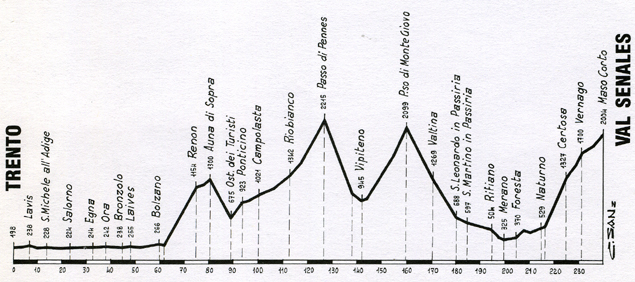
On first glance, the stage profile will resemble one of those pre-2008 Vuelta stage profiles, from the era where they used those horrible profiles with the inconsistent y-axis, stretching climbs out so they looked far flatter and longer than they were. For example,
this was the profile for the 2007 Abantos stage (come to think of it, that belongs in the 'worst of race profiles' thread). Similarly,
this was the Ávila stage - would it surprise you to learn that Abantos and Mijáres are not eternal 2-3% grinds with super steep descents? But here, it is true - I'm using much shallower climbs than the relevant descents of these climbs. Auna di Sopra is
not actually that shallow from this side - 20km @ 5,3% although the first 12km are at around 6-7% - however because we're rejoining a valley road higher up and the first part of the descent is very steep, it looks quite insignificant by contrast. Similarly, the Passo Pennes is a monstrously hard ascent from the north, however its north face begins in Vipiteno-Sterzing, same as the climb up to Ridnaun, so we have the opposite side to climb, which is a very long drag that slowly reveals its difficulty as it gets higher and higher, ramping up the gradients until a final 4km at 9%. We're doing the final 36km of
this profile, so you can see by the super-long profile this is more akin to, say, Sestrières from Pinerolo as a cat.1 climb than the kind of monster ascent like the other side of the climb. It does, however, crest 30km from home, so certainly if the break is taking this one it could be worth a speculative go from distance to get rid of any fugitivo who may be a threat in the sprint, or to see whose legs are ready for climbing should the group come back together on the descent.
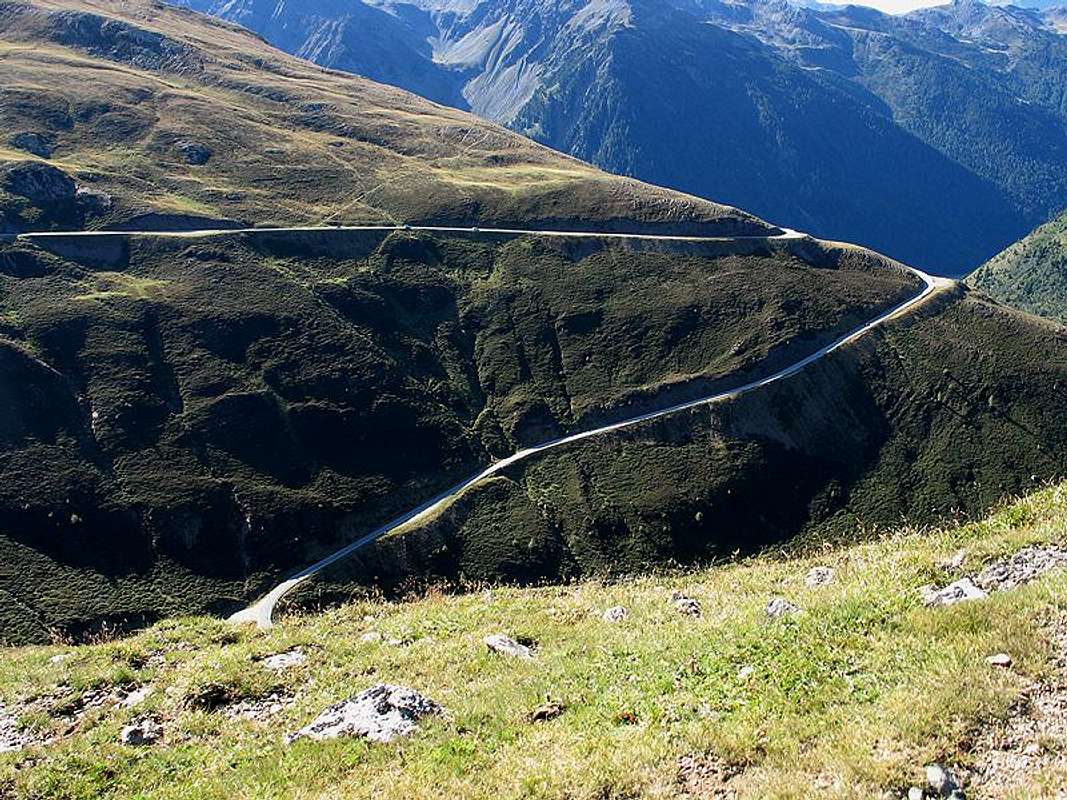
As well as being very dramatic, the descent is very steep - averaging nearly 9% for 14km - and includes a number of tricky switchbacks that will mean that if the group is sufficiently trimmed, some pressure could be put on the weaker descenders in the bunch, whether it be through a concerted group attack such as Movistar in Paris-Nice back in 2012, or through a dedicated specialist such as a Savoldelli or a Nibali pushing on in the hope of isolating or eliminating somebody who may have reason to be circumspect or who has a poor descending history. There's only a short flat period for them to utilize before the 3km @ 10% climb that leads to that sapping run-in to the line; when you're trying to chase on, little can be more sapping than getting to the top of a steep climb and then realising you don't get any respite, you've got to keep putting the power down and switch to TT mode.
Stage proposal #4: Sankt Anton am Arlberg - Ridnaun-Val Ridanna, 201km

This is the alternative, where we go full medium-mountain and present something that moves between Austria and Italy while presenting something akin to a hybrid between Liège-Bastogne-Liège and the Giro di Lombardia in profile, alternating short steep climbs with medium length and steep climbs. Obviously the profiling has been based on a Tour of the Alps/Österreichrundfahrt scale, as in the Giro d'Italia only two of those climbs would be categorized, just for the lols. This would probably be best served as a Tour of the Alps stage, as I'm not sure what kind of preceding stage could yield a start in Sankt Anton in the Giro (again - Serfaus? Samnaun? Maybe if we're super lucky, something like Stelvio then Sulden or Malles Venosta?) although if they went all out with a stage over Rombo and finishing at Hochsölden or Rettenbachferner, a stage starting in Sölden (it is a ski resort town, after all) would be able to cut about 25-30km off this stage and join it either at Imst (before Holzleitensattel) or at Telfs (before Möserer Sattel) to get the benefit of the rest of the challenges.
This one is all about small and difficult obstacles, and includes a number of them. The first really significant one will be Möserer Sattel,
essentially 7km @ 8,5% and only used in that one Giro stage from 1988 mentioned above. The Austrian Nordic sports mecca of Seefeld, which hosted the Nordic events at the 1964 and 1976 Winter Olympics (save for the large hill ski jumping, which was at the iconic Bergiselschanze), has one of the most prestigious events of the Nordic Combined calendar every season, and will host the 2019 Nordic World Championships, lies just 4km from the summit of the climb, so you can be rest assured you'll hear more about it in this series - Seefeld offers some of the most varied sets of options of all, after all - and while I could have gone full-on and thrown in Silzer Sattel and Kühtai Sattel here, I'd still have been left with the same finale so it would have been a pointless addition of such a major ascent, other than to wipe out one group of potential stage winners.

After this we head into Innsbruck for a bit of a 2018 World Championships play-about, including the Hungerburg climb which was seen in the Tour of the Alps this season,
won by Michele Scarponi from a small group, then the reverse side of the Patsch climb that has been in the mooted route, passing past the Igls bobsleigh run from the Innsbruck Winter Olympics. This road, at the summit of the climb with 63km remaining, joins after a period of rolling terrain onto the long and mostly false flat route up to the most famous crossing through the mountains between the two countries, the Brennerpass. However, this is supposed to be a hilly to medium mountain banana skin of a stage, so I've thrown in a little curveball in the form of the short, steep and narrow ascent up to the hamlet of Nößlach.
It's
ridable, but because traffic on the Brennero makes it unwelcoming for cyclists outside of when it's closed for racing, many of these areas off of the main Brenner pass are not that well known to cyclotourists. This is essentially another climb of 3km @ 10%, along similar lines to Mende or the Alto do Malhão, 42km from the line. It's where the break may be, well, broken, if they're who are contesting it, and it's where you need to be shedding the opposition's domestiques if that's your aim too. After that, however, it's a gradual descent before
the final 5km of the Brenner including that 1km @ 8,5%, the only severe ramp of the whole climb, cresting just before 30km from home. After that, it's a very fast descent - although as we're on the SS12 and haven't actually been on the Autostrada, there are some hairpin bends to consider, though compared to many roads the riders will take on these are fairly wide and inconsequential. That descent will deposit the riders in Vipiteno-Sterzing, ready for the final climb up to Ridnaun and then, once more, that painful final 4km of chasing into the finish.
It's a crying shame that Ridnaun doesn't host cycling. It's beautifully scenic, as we know from the biathlon (I actually wish they'd host higher level biathlon more often, to get more coverage from the site, as I like being able to see more of venues we normally only get summary videos from), and the possibilities are pretty great to produce some decisive racing here, without the easy way out that is a mountaintop finish. And indeed - as I'll show in some posts where mountain stages of
any kind aren't really a possibility - you can do a lot more than just mountain stages with the Nordic venues, because they don't owe their raison d'être to the mountains, unlike their Alpine counterparts.
 Flat stage
Flat stage 















